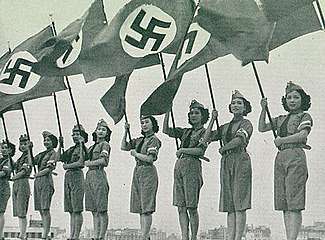Honorary Aryan
Honorary Aryan (German: Ehrenarier) was an expression used in Nazi Germany to describe the unofficial status of persons, including Mischlinge, who were not recognized as belonging to the Aryan race, according to Nazi standards, but informally considered to be part of it.[1]

The prevalent explanation as to why the status of "honorary Aryan" was bestowed by the Nazis upon other non-Nordic – or even less exclusively, non-Indo-Iranian/European peoples – is that the services of those peoples were deemed valuable to the German economy or war effort,[2] or simply for other purely political or propaganda reasons.
In the Independent State of Croatia, a Nazi client country, this term was used by Ante Pavelić to protect from persecution some Jews who had been useful to the state. [3]
Notable inclusions
- Amin al-Husseini, an Arab and the Mufti of the British Mandate of Palestine, "was granted the status of honorary Aryan" by the Nazis[10][11], whereas Arabs as a whole were considered by Hitler to be "half-monkeys".[12][13][14]
- Stephanie von Hohenlohe, a Jewish Austrian princess by marriage and spy for Nazi Germany and declared an honorary Aryan by Heinrich Himmler.[15]
- Emil Maurice, Hitler's first personal chauffeur and a very early member of the Nazi Party, was a member of the SS, but ran afoul of Heinrich Himmler's rules, which required SS men to have deep Aryan ancestry, since Maurice's great-grandfather was Jewish. Himmler considered him to be a security risk, and tried to have him thrown out, but Hitler stood by his old friend and, in a secret letter dated 31 August 1935, required Himmler to allow Maurice and his brothers to remain in the SS. They were considered to be "Honorary Aryans".[16]
- Sophie Lehar (nee Paschkis), the wife of the composer Franz Lehár had been Jewish before her conversion to Catholicism upon marriage. Hitler enjoyed Lehár's music and the Nazis made some propaganda use of it. After Joseph Goebbels' intervened on Lehár's behalf,[17] Mrs. Lehár was given in 1938 the status of "honorary Aryan" by marriage.[18] This certainly saved her life; during the war, attempts were made at least once to have her deported, which was stopped only due to her status.
See also
- Anti-Comintern Pact
- Germany–Japan industrial co-operation before World War II
- German–Japanese relations
- Honorary whites
- Presidential exemption (Slovak State)
- Racial policy of Nazi Germany
- Tripartite Pact
References
- Steiner, John; Freiherr von Cornberg, Jobst (1998). Willkür in der Willkür : Befreiungen von den antisemitischen Nürnberger Gesetzen [Arbitrariness in arbitrariness:Exemptions from the anti-Semitic Nuremberg Laws] (pdf) (in German). Institut fûr Zeitgeschichte.
Den Begriff „Ehrenarier" gab es offiziell nicht, nur in der Umgangssprache. Er bedeutete wohl, daß ein jüdischer Mischling auf Grund seiner Stellung und Verdienste im Reich wie ein Arier angesehen wurde und keinerlei Anstalten machen mußte, eine Besserstellung oder Gleichstellung durch Hitler zu erreichen.
- "In the Wind", The Nation Vol. 147, Issue 7. August 13, 1938
- Rees, Laurence (2017). The Holocaust: A New History. PublicAffairs. ISBN 9781610398459.
- Farrell, Joseph P. (2004). Reich of the Black Sun: Nazi Secret Weapons & the Cold War Allied Legend (illustrated ed.). Adventures Unlimited Press. p. 117. ISBN 9781931882392. Retrieved 30 July 2018.
- Adams, James Truslow (1933). History of the United States: Cumulative (loose-leaf) history of the United States. C. Scribner's sons. pp. 260, 436. Retrieved 30 July 2018.
- Delgado, Richard; Stefancic, Jean (1997). Critical White Studies: Looking Behind the Mirror. Temple University Press. p. 53. ISBN 9781439901519. Retrieved 30 July 2018.
- Narula, Uma; Pearce, W. Barnett (2012). Cultures, Politics, and Research Programs: An International Assessment of Practical Problems in Field Research. Routledge. p. 105. ISBN 9781136462689. Retrieved 30 July 2018.
- Ahmed, Akbar (2018). Journey into Europe: Islam, Immigration, and Identity. Brookings Institution Press. p. 379-380. Retrieved 23 March 2020.
In 1936 the government began an investigation to decide the racial status of the Turks, and the Turkish press announced the results in the press in the headline "The Turks are Aryans!"
- Ehrenreich, The Nazi ancestral proof, p.10
- Dalin David G. and Rothman, John F. (2009) Icon of Evil: Hitler's Mufti and the Rise of Radical Islam, Transaction Publishers. p.47 ISBN 978-1-4128-1077-7.
- Rigg, Bryan Mark (2002) Hitler's Jewish soldiers: the untold story of Nazi racial laws and men of Jewish descent in the German military. Lawrence, Kansas: University Press of Kansas. ISBN 978-0-7006-1178-2
- Ahmed, Akbar (2018). Journey into Europe: Islam, Immigration, and Identity. Brookings Institution Press. p. 380. Retrieved 23 March 2020.
Hitler's contempt for non-Aryan peoples, however, was difficult to contain: He is on record as referring to Arabs as "half-monkeys."
- Stefan Wild (1985). "National Socialism in the Arab near East between 1933 and 1939". Die Welt des Islams. New Series. 25 (1/4): 126–173. doi:10.2307/1571079. JSTOR 1571079.
Wir werden weiterhin die Unruhe in Fernost und in Arabien schüren. Denken wir als Herren und sehen in diesen Völkern bestenfalls lackierte Halbaffen, die die Knute spüren wollen. (We will continue to stir up unrest in the Far East and in Arabia. Let us think as Men and at best we will see lacquered half-monkeys in these peoples who want to feel the whip.)
- Al-Hamarneh, Ala and Thielmann, Jorn (2008) Islam and Muslims in Germany. Brill. ISBN 9789004158665 p.203,n.49
- Jim Wilson (2011) Nazi Princess: Hitler, Lord Rothermere and Princess Stephanie von Hohenlohe ISBN 978-0-7524-6114-4.
- Hoffmann, Peter (2000) [1979]. Hitler's Personal Security: Protecting the Führer 1921–1945. New York: Da Capo Press. pp.50-51 ISBN 978-0-30680-947-7
- Elke Froehlich (Hrsg.): Die Tagebücher von Joseph Goebbels. Teil I Aufzeichnungen 1923–1945 Band 5. Dez 1937 – Juli 1938. K.G. Saur, München 2000, S. 313.
- Frey (1999), pp. 338f.